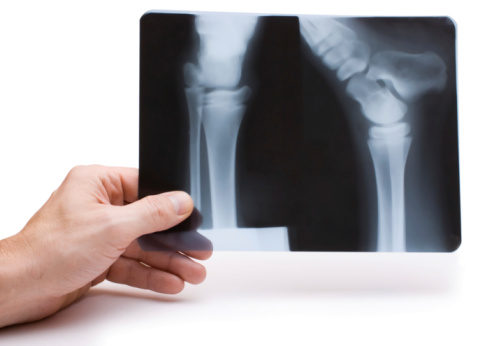Calcium and strontium are two metallic elements that have effects on human metabolism due to their ability to serve in the primary mineral component of bone: the structural complex hydroxyapatite (HA; Ca5(PO4)3(OH). Hydroxyapatite is responsible for bone’s great compression strength. It is also the component that is in the greatest flux, moving in and out of the bone as the skeleton is remodeled, or as calcium is needed for other systems in the body.
While both calcium and strontium can be found in HA, the relative concentrations, lifetimes and metabolic functions of these two minerals are dramatically different. Because of these differences, both have been advocated as important nutrients for bone health. In this article, we briefly explore the nutritional roles of calcium; the expanded online version of this article discusses both these elements.
Calcium
Calcium is an essential metallic element in human nutrition, fulfilling a wide variety of biological roles. Apart from its celebrated structural role as a primary mineral component of bones and teeth, it also directly participates in a myriad of metabolic reactions, including those that control energy production, muscle contraction, heartbeat, blood coagulation and the functions of the immune, nervous, and endocrine systems. Humans consume calcium in a variety of dietary foods (e.g., dairy products, dark green vegetables; and to a lesser extent meats, fish and legumes), and through supplementation. The average American adult is estimated to intake between 500 and 800 mg of calcium per day, with men having higher average intakes than women. This average intake is significantly less than the established Dietary Reference Intake (DRI) of 1,000 mg/day (adults under 50) or 1,200 mg/day (adults over 50). Compounding factors such as poor vitamin D status and carbonated soft-drink consumption have been shown to further decrease the amount of usable calcium in the body. Studies have shown that poor calcium status, especially early in life, can have lasting, irreversible, detrimental effects as we age.
Supplemental calcium is available in a variety of different forms. There has been considerable debate as to the merits of each, citing a variety of advantages (e.g., higher absorption, “food-derived,” etc.). To understand and make an informed decision on the relative merits of a particular calcium source, it is important to realize that nearly all have been demonstrated to serve as good calcium sources under most conditions, and any differences between their absorption are modest. This is due to the complex, highly regulated system that the human uses to absorb calcium.
Calcium is absorbed primarily in the small intestine both actively (by a transport system) and passively (by diffusion), generally in its ionized free form (Ca++) (reviewed in [1]). Active transport responds to levels of calcium in the body and only allows the absorption if more calcium is needed. It is this active transport system that is reliant on vitamin D (calcitriol). Passive diffusion, the second route of calcium absorption, relies on the movement of calcium through the gaps between intestinal cells. As its name would suggest, it is not regulated, does not depend on vitamin D and is not affected by age. Presumably, any soluble calcium can enter through this route (both ionized and soluble calcium chelates), but the amount of calcium absorbed through passive diffusion is low (8–23% of the total dose in normal adults) (2). The combination of active and passive absorption allows the digestive system to rapidly respond to the body’s calcium requirements; ensuring calcium is efficiently absorbed when dietary intake is low, but preventing over-absorption (and undue stress on the renal system) when dietary calcium levels are high.
In healthy individuals with sufficient calcium intake, the rates of ionization and absorption of different calcium salts are similar. For example, mean apparent calcium absorptions (as a percentage of intake) have been calculated based on 3–8 studies (for each of four calcium salts) and 12–14 studies (for carbonate and milk calcium): carbonate, from 26.4 (fasting) to 29 (meal), citrate/malate from 32 (fasting) to 37 (meal), citrate 23.5 (fasting), lactate/gluconate 24.5 (fasting), chloride 30.6 (fasting), milk 32.4, cheese 32.8, mineral waters 32.3 (3). Although these numbers must be interpreted cautiously (as studies have been performed using different test groups and study parameters) it is clear, when averaged over several studies, calcium absorption is limited to about one quarter to one third of ingested dose.
One notable exception to the above limits is the effect of dividing calcium dosage. This significantly increases fractional absorption by preventing the saturation and shutdown of the active transport system. In one particularly illustrative (and extreme) example, dividing a 1,000 mg dose into 17 evenly-spaced doses over an eight-hour period increased its fractional absorption by almost 100% [4]. In short, it would appear that the manner which calcium is consumed (how much and when) has a much more significant influence on absorption than the nature of the calcium source.
Given the parity in absorption between sources of dietary calcium, it would appear that any calcium source can provide dietary needs. While this is true, some calcium sources may have certain advantages in their bioavailability. Recall that calcium bioavailability describes not only absorption, but also the activity of the calcium once it crosses the intestinal lumen (3). In discussing the bioavailability of calciums, it is convenient to partition them into different chemical groupings. Calcium salts are the most common calcium sources; they are insoluble combinations of calcium and another compound that become ionized to free calcium upon ingestion. The often (unfairly) maligned calcium carbonate, is a notable example; it is well studied with more evidence of increased bone mineral density than any other calcium source except for diary calcium. Calcium phosphates (there are several types) may be beneficial for some in that they provide phosphorus, an important bone mineral. While most adults get enough phosphorus in their diets, a significant population of older women (10% of women over 60 and 15% of women over 80) are getting less than 70% of the RDA (5). Phosphorus is required for the formation of calcium hydroxyapatite (the crystal form of calcium in bones).
Calcium chelates are complexes of calcium and other organic molecules such as organic acids (citrate, malate, threonate, ascorbate) or amino acids (aspartate). Like salts, they can dissociate into ionized calcium for the active transport mechanism, but they are more resistant to this process. Unlike salts, however, they are soluble even if not ionized; this may allow them to be directly absorbed by passive diffusion. The advantages to chelates appear to be for situations in which calcium digestion is sub-optimal; they exhibit less of an absorption penalty when taken between meals, and they are the choice for individuals with achlorhydria (insufficient stomach acid) or who are taking proton-pump inhibitors or histamine blockers [6]. 
Matrix-bound calciums are complexes of calcium or calcium salts with an organic matrix (proteins, polysaccharides). Matrix-bound calciums are often marketed as “food-based” or “recognized by the body as food,” but these statements should be interpreted with caution. For most, the calcium in these matrices is actually a calcium salt. Algal, eggshell and shellfish calciums are crystals of calcium carbonate; milk and bone calciums are types of calcium phosphate. Therefore, the human body recognizes several of the matrix-bound calciums in the same way as it would a calcium salt, requiring ionization prior to absorption.
As one would expect from our knowledge of calcium metabolism, the benefits of matrix-bound calcium over other forms has more to do with the nature of the matrix, rather than the calcium itself. Algal and eggshell matrices contain additional trace elements (7); eggshell may also contain bone-specific growth factors. Milk calcium can have a significant portion of colloidal phospho-caseinate that may prevent calcium precipitation and prolong calcium residence time in the gut (3). This sustained calcium dose has a stimulatory effect on passive diffusion. Ossein-hydroxyapatite complex (OHC) is a particularly well-characterized matrix-bound calcium isolated from bovine bone (for a summary of 18 comparative OHC studies, see [8]). Ossein is rich in proteins that stimulate bone growth: collagens, osteocalcin, and growth factors (IGFs, TGF-B, bone morphogenic protein). When compared to calcium alone (as calcium carbonate), the ossein matrix provided an additional increase in BMD of at least 1% in the various studies (for total BMD increases of up to 5% in vertebrae).
Strontium
The hydroxyapatite crystals that serve as the mineral component of bone tissue are typically formed of calcium, however, other elements can substitute for calcium in these crystal structures. Strontium is one such element. The chemical similarity of calcium and strontium has led to the development of strontium-based drugs (and supplements) for promoting bone growth. WF
Kevin Connolly, Ph.D., is a Jarrow Formulas consultant. Previously, he spent five years as the director of scientific affairs and product development at Jarrow Formulas (www.jarrow.com). Additionally, he spent 15 years in basic biochemistry research elucidating such diverse mechanisms as bacterial antibiotic resistance and collagen synthesis. He is an inventor on several medical device patents and is a frequent guest on radio health programs throughout the country.
References
1. F. Bronner, “Mechanisms of Intestinal Calcium Absorption,” J. Cell. Biochem. 88 (2), 387–393 (2003).
2. McCormick, C.C., Passive Diffusion Does Not Play a Major Role in the Absorption of Dietary Calcium in Normal Adults,” J. Nutr. 132 (11), 3428–3430 (2002).
3. L. Gueguen and A. Pointillart, “The Bioavailability of Dietary Calcium,” J. Am. Coll. Nutr. 19 (2 Suppl.), 119S–136S (2000).
4. R.P. Heaney, B. Berner and J. Louie-Helm, “Dosing Regimen for Calcium Supplementation,” J. Bone Miner. Res. 15 (11), 2291 (2000).
5. R.P. Heaney, “Phosphorus Nutrition and the Treatment of Osteoporosis,” Mayo Clin. Proc. 79 (1), 91–97 (2004).
6. D.A. Straub, “Calcium Supplementation in Clinical Practice: A Review of Forms, Doses and Indications,” Nutr. Clin. Pract. 22 (3), 286–296 (2007).
7. A. Schaafsma, et al., “Mineral, Amino Acid, and Hormonal Composition of Chicken Eggshell Powder and the Evaluation of Its Use in Human Nutrition,” Poult. Sci. 79 (12), 1833–1838 (2000).
8. C. Castelo-Branco, et al., “Efficacy of Ossein-Hydroxyapatite Complex Compared with Calcium Carbonate to Prevent Bone Loss: A Meta-Analysis,” Menopause, 16 (5), 984–991 (2009).
Published in WholeFoods Magazine, July 2010 (published online ahead of print June 18)









